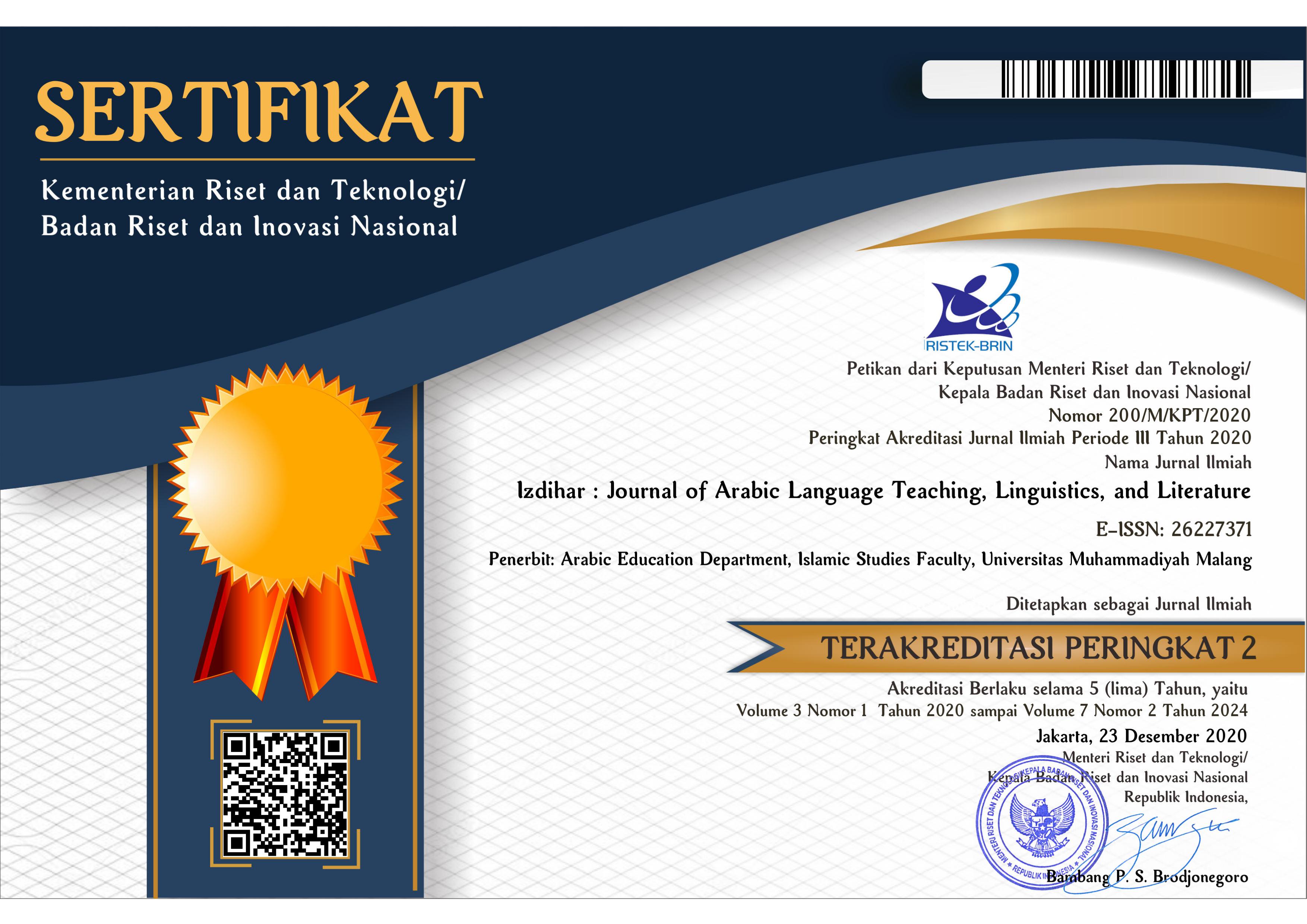Utility of the Smart App Creator Application as an Arabic Learning Media
DOI:
https://doi.org/10.22219/jiz.v4i3.17886Keywords:
Arabic Language, Learning Media, Smart App Creator AplicationAbstract
The difficulty of practical media makes educators not innovate in the learning process, especially in delivering subject matter. Even though the technology is beneficial for this, one of which is the Smart App Creator application. Smart App Creator is very easy to use by educators because this application is a user interface; easy to understand. This research was conducted to determine the benefits of a Smart App Creator software in making learning media. This research method was qualitative with a library model; analyzed national and international journals and interview models; interviewed three teachers and nine students at different Islamic junior high schools. The results of this study explained that learning media designed using Smart App Creator software can provide motivation and foster enthusiasm for learning of students because this software contains elements of text, audio, video, and animation that are combined in one media; what's interesting is that this application can be opened. On a laptop or computer without installing the main application and can also be installed on an Android smartphone and has the advantage of not being connected to the Internet.
Downloads
References
Adiyanti, D. S., M.amin, S., & Muslimin, I. (2020). Peningkatan Hasil belajar siswa menggunakan media video pembelajaran pada siswa SD Kelas VI SD Negeri 4 Sidoluhur Kecamatan Lawang Kabupaten Malang. Nasional Conference For Ummah, 1.
Aziz, A., & Dinata, Y. M. (2019). Bahasa Arab modern dan kontemporer; kontinuitas dan perubahan. Mumtaz: Jurnal Studi Al-Qur’an Dan Keislaman, 3(2), 152–168. https://doi.org/10.36671/mumtaz.v3i2.38
Azizah, A. R. (2020). Penggunaan Smart Apps Creator (SAC) untuk mengajarkan global warming. Prosiding Seminar Nasional Fisika (SNF) Unesa, 4(2), 72–80. https://fisika.fmipa.unesa.ac.id/proceedings/index.php/snf/article/view/143
Baridah, S. (2014). Metode pembelajaran mufradat di MTS Nurul Islam Clekatakan Kecamatan Pulosari Kabupaten Pemalang Tahun Pelajaran 2013/2014 [IAIN Purwokerto]. http://repository.iainpurwokerto.ac.id/id/eprint/1729
Bendridi, A. (2021). Uses Of Communicative And Collaborative Activities In E-Learning: Moodle Platform As A Model/ Istikhdaamat al-ansyithoh at-tawaashulillah wa at-ta’aawuniyah fii ta’liim al-iliktrony: minashshotu Moodle namuudzajan . Ijaz Arabi Journal of Arabic Learning, 4(2), 242–267. https://doi.org/10.18860/ijazarabi.v4i2.10923
Burbules, N. C., Fan, G., & Repp, P. (2020). Five trends of education and technology in a sustainable future. Geography and Sustainability, 1(2), 93–97. https://doi.org/10.1016/j.geosus.2020.05.001
Cahyono, A. S. (2016). Pengaruh media sosial terhadap perubahan sosial masyarakat di Indonesia. Jurnal Ilmu Sosial & Ilmu Politik Diterbitkan Oleh Fakultas Ilmu Sosial & Politik, Universitas Tulungagung, 9(1), 140–157. http://www.jurnal-unita.org/index.php/publiciana/article/download/79/73
CHEN, C., CHEN, Y., YU, C., HONG, Z., HUANG, J., & HO, Y. (2016). Application of ebooks in elementary school disaster prevention education. DEStech Transactions on Engineering and Technology Research, amita. https://doi.org/10.12783/dtetr/amita2016/3666
Darmalaksana, W. (2020). Metode Penelitian kualitatif studi pustaka dan studi lapangan. Pre-Print Digital Library UIN Sunan Gunung Djati Bandung, 1–6. http://digilib.uinsgd.ac.id/32855/1/Metode Penelitian Kualitatif.pdf
Dewantara, J. A., & Budimasyah, D. (2018). Mutual Cooperation Based Go Green: New Concept of Defense Country. January 2018. https://doi.org/10.2991/acec-18.2018.10
Fahrurrozi, A. (2014). Pembelajaran bahasa Arab : Problematika dan solusinya. Arabiyat: Jurnal Pendidikan Bahasa Arab Dan Kebahasaaraban, 1(2), 161-180. https://doi.org/10.15408/a.v1i2.1137
Fiani Irma Nur, Ahsanuddin Mohammad, M. R. (2021). The effectiveness of using kahoot ! application as an evaluation tool in Arabic vocabulary learning at Madrasah Ibtidaiyah. Izdihar : Journal of Arabic Language Teaching, Linguistics, and Literature, 4(2), 243–256. https://doi.org/https://doi.org/10.22219/jiz.v4i2.17186
Ghavifekr, S., & Rosdy, W. A. W. (2015). Teaching and learning with technology: Effectiveness of ICT integration in schools. International Journal of Research in Education and Science, 1(2), 175–191. https://doi.org/10.21890/ijres.23596
Hayes, C., & Sumekar, T. A. (2017). Pengaruh brain training terhadap tingkat inteligensia. Diponegoro Medical Journal (Jurnal Kedokteran Diponegoro), 6(2), 402–416. https://doi.org/10.14710/dmj.v6i2.18556
Hidayah, N., Ridwan, N. A., Mahliatussikah, H., Dariyadi, M. W., & Bekhoula, B. (2020). Akuarintar as a media in arabic teaching and learning for deaf towards Sustainable Development Goals (SDGS) 2030. Izdihar : Journal of Arabic Language Teaching, Linguistics, and Literature, 3(3), 181–196. https://doi.org/10.22219/jiz.v3i3.13921
Hidayat, N. S. (2012). Problematika pembelajaran bahasa Arab. An-Nida’, 37(1), 82–88. https://doi.org/http://dx.doi.org/10.24014/an-nida.v37i1.315
Holidazia, R., & Rodliyah, R. S. (2020). Strategi siswa dalam pembelajaran kosa kata bahasa Inggris. Jurnal Penelitian Pendidikan, 20(1), 111–120. https://doi.org/10.17509/jpp.v20i1.24562
Kamlin, M. B., & Keong, T. C. (2020). Adaptasi video dalam pengajaran dan pembelajaran abstrak adopting video in teaching and learning abstract pengenalan tinjauan literatur teori kognitif pembelajaran multimedia mayer. Malaysian Journal of Social Sciences and Humanities (MJSSH), 5(10), 105–112. https://msocialsciences.com/index.php/mjssh/article/view/508
Khoirudin, R., Ashadi, A., & Masykuri, M. (2021). Smart Apps Creator 3 to improve student learning outcomes during the pandemic of COVID-19. JPBI (Jurnal Pendidikan Biologi Indonesia), 7(1), 25–34. https://doi.org/10.22219/jpbi.v7i1.13993
Kirom, A. (2017). Peran guru dan peserta didik dalam proses pembelajaran berbasis multikultural. Jurnal Pendidikan Agama Islam, 3(1), 69–80. https://jurnal.yudharta.ac.id/v2/index.php/pai/article/view/893
Luh, N., & Ekayani, P. (2021). Pentingnya penggunaan media siswa. Pentingnya Penggunaan Media Pembelajaran Untuk Meningkatkan Prestasi Belajar Siswa, March, 1–16.
Mahnun, N. (2012). Media pembelajaran (Kajian terhadap langkah-langkah pemilihan media dan implementasinya dalam pembelajaran). An-Nida’, 37(1), 27–35. https://doi.org/http://dx.doi.org/10.24014/an-nida.v37i1.310
Merkoune, H. (2021). Metacognitive learning strategies for the acquisition of cognitive and methodological competencies of the Arabic language/ Istiraajiyiyyatu at-ta’allum ma waroan al-ma’rifah wa atsaruha fii iktisaabi al-kafaaat al-ma’rifiyyah wa al-manhajiyyah limaddaati al-lughoh Al-Arabiyyah. Ijaz Arabi Journal of Arabic Learning, 4(2), 268–284. https://doi.org/10.18860/ijazarabi.v4i2.11878
Mudinillah, A. (2021). Software untuk Media Pembelajaran (Dilengkapi dengan Link Download Aplikasi) (N. E. Putri (ed.); 1st ed.). Bintang Pustaka Madani. https://scholar.google.com/scholar?cluster=13854761131920543422&hl=en&oi=scholarr
Nurseto, T. (2012). Membuat Media Pembelajaran yang Menarik. Jurnal Ekonomi Dan Pendidikan, 8(1), 19–35. https://doi.org/10.21831/jep.v8i1.706
Oensyar, K. R., & Hifni, A. (2015). Pengantar Metodologi Pembelajaran Bahasa Arab. IAIN Antasari Press.
Pane, A., & Darwis Dasopang, M. (2017). Belajar dan pembelajaran. Fitrah:Jurnal Kajian Ilmu-Ilmu Keislaman, 3(2), 333. https://doi.org/10.24952/fitrah.v3i2.945
Phelps, A., Colburn, J., Hodges, M., Knipe, R., Doherty, B., & Keating, X. D. (2021). A qualitative exploration of technology use among preservice physical education teachers in a secondary methods course. Teaching and Teacher Education, 105, 103400. https://doi.org/10.1016/j.tate.2021.103400
Pienimäki, M., Kinnula, M., & Iivari, N. (2021). Finding fun in non-formal technology education. International Journal of Child-Computer Interaction, 29, 100283. https://doi.org/10.1016/j.ijcci.2021.100283
Prasetiyo, W. H., Kamarudin, K. R., & Dewantara, J. A. (2019). Surabaya green and clean: Protecting urban environment through civic engagement community. Journal of Human Behavior in the Social Environment, 29(8), 997–1014. https://doi.org/10.1080/10911359.2019.1642821
Pulungan, H. R., Suhono, N., & Sumarlam, N. (2019). Serapan bahasa Arab pada budaya akikah ni daganak tubu berbahasa angkola. Ranah: Jurnal Kajian Bahasa, 8(1), 33. https://doi.org/10.26499/rnh.v8i1.975
Rubianto, A. (2020). Pengembangan modul berbasis aplikasi android untuk mata kuliah ilmu bahan teknik pada prodi d3 teknik mesin Universitas Negeri Malang. Jurnal Teknik Mesin Dan Pembelajaran, 2(2), 124. https://doi.org/10.17977/um054v2i2p124-133
S, F. R., & Baroroh, R. U. (2020). Strategies and methods of learning arabic vocabulary/ strategi dan metode pembelajaran kosakata bahasa Arab. Ijaz Arabi Journal of Arabic Learning, 3(2), 291–312. https://doi.org/10.18860/ijazarabi.v3i2.10062
Sari, M., & Asmendri. (2018). Penelitian kepustakaan (library research) dalam penelitian pendidikan IPA. Penelitian Kepustakaan (Library Research) Dalam Penelitian Pendidikan IPA, 2(1), 15. https://ejournal.uinib.ac.id/jurnal/index.php/naturalscience/article/view/1555/1159
Suaibah, L., & Rahman, T. (2020). Smart tree learning media - we can be based on android for Arabic subjects/ media pembelajaran pohon pintar-kita bisa berbasis android untuk matakuliah bahasa Arab. Ijaz Arabi Journal of Arabic Learning, 3(1), 89–106. https://doi.org/10.18860/ijazarabi.v3i1.8215
Suhartati, O. (2021). Flipped classroom learning based on Android Smart Apps Creator (SAC) in Elementary Schools. Journal of Physics: Conference Series, 1823(1). https://doi.org/10.1088/1742-6596/1823/1/012070
Suryaningtyas, V. W., Nugroho, R. A., Cahyono, S. P., Nababan, M. R., & Santosa, R. (2019). Translation Learning enrichment using smart an attempt to design a mobile application in translation for tourism purpose course. 2019 International Seminar on Application for Technology of Information and Communication (ISemantic), 542–547. https://doi.org/10.1109/ISEMANTIC.2019.8884273
Sutejo, & Yogi Ersan Fadrial. (2021). Pelatihan pembuatan media pembelajaran menggunakan aplikasi Smart Apps Creator di Smk Negeri 2 Pinggir. J-COSCIS : Journal of Computer Science Community Service, 1(2), 45–52. https://doi.org/10.31849/jcoscis.v1i2.7215
u-Smart Technology Corporation Limited. (2016). Smart Apps Creator. East Way to Design. https://smartappscreator.com/en/
Widiastika, M. A., Hendracipta, N., & Syachruroji, A. (2020). Pengembangan media pembelajaran mobile learning berbasis android pada konsep sistem peredaran darah di Sekolah dasar. Jurnal Basicedu, 5(1), 47–64. https://doi.org/10.31004/basicedu.v5i1.602
Yusof, N., Baharudin, H., Hamzah, M. I., & Abdul Malek, N. I. (2021). fuzzy delphi method application in the development of i-aqran module for Arabic vocabulary consolidation. Ijaz Arabi Journal of Arabic Learning, 4(2), 331–351. https://doi.org/10.18860/ijazarabi.v4i2.12050
Zurweni and Haryanto, H. S. A. M. and Z. (2021). Pengembangan media pembelajaran interaktif mobile learning berorientasi pada kemampuan belajar mandiri siswa untuk materi kesetimbangan Kimia [Universitas Jambi]. https://repository.unja.ac.id/id/eprint/21468
Downloads
Published
How to Cite
Issue
Section
License
Copyright (c) 2021 Yelfi Dewi S, Amrina Amrina, Gazali Gazali, adam mudinillah, Annisa Agustina, Yovan Luksfinanto

This work is licensed under a Creative Commons Attribution-ShareAlike 4.0 International License.
Copyright Notice
Authors who publish with this journal agree to the following terms:
- Authors retain copyright and grant the journal right of first publication with the work simultaneously licensed under a Creative Commons Attribution-ShareAlike 4.0 International License that allows others to share the work with an acknowledgment of the work's authorship and initial publication in this journal.
- Authors are able to enter into separate, additional contractual arrangements for the non-exclusive distribution of the journal's published version of the work (e.g., post it to an institutional repository or publish it in a book), with an acknowledgment of its initial publication in this journal.
- Authors are permitted and encouraged to post their work online (e.g., in institutional repositories or on their website) prior to and during the submission process, as it can lead to productive exchanges, as well as earlier and greater citation of published work (See The Effect of Open Access).
Copyright (c) 2019 Izdihar : Journal of Arabic Language Teaching, Linguistics, and Literature

This work is licensed under a Creative Commons Attribution-ShareAlike 4.0 International License.

















